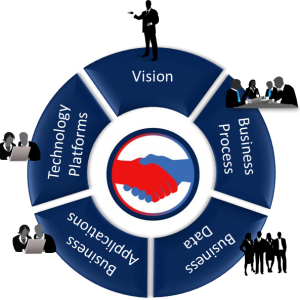People have differing views on what is a Vision. However all of these include a picture, a future positioning, and direction or goal. Features of a Vision should be inspiring, motivating, inclusive and create the desire and energise your workforce to commit to achieving the aims of the organisation.

Through thoughtful leadership, a Vision will realise meaning and purpose to the work of an organisation (function/team) and provide guidance at a strategic level through to individual groups.
When along the journey to create Change, a Vision becomes paramount and should inform:
- Why are you doing this?
- What do you plan to achieve?
- Who is involved?
The key factor in having a Vision is to ensure that it becomes a Shared Vision by all those who will realise it, and this will form the commitment you need to make it happen.
Why do this?
- Show what the future looks and feels
- Foundation of your business plan
- To motivate your people
- Attract talent

Setting the Scene – We bring together the relevant stakeholders and get to know them well. Their insight on your organisation’s culture, challenges in delivering services and their future needs informs the design of the Vision workshop. This is coupled with the right attendees to ensure the Vision belongs to the Group.
Vision Creation – We bring together the right tools and techniques with leading experts in your field to provide “Art of the Possible” injection into the Vision. At the end of our sessions you will have a Vision that the Group can stand behind and champion.
Holding the Vision – We help you to create a set of “Guiding Principles” that underpin your Vision and are used to support your teams in decision making. These principles are essential in ensuring that you achieve your goals.
Roadmap – Based on your Vision and Guiding Principles we support the creation of an outline Roadmap consisting of initiatives and a timeline that delivers the desired outcomes and matches pace for delivery.
Your Journey – We are keen to make sure that the Roadmap becomes a living document and action is taken. Our experts will help you shape your Portfolio of Change and design the best approaches to deliver your Portfolio of projects

There are numerous definitions of Strategy. Our definition is simple in that it is a method to deliver your business plan for the future whilst taking on board the organisations current position and external influences to achieve the desired results.
Organisations produce their five year Financial Plans that will carry them into the future; these can be very outward looking and contain numerous assumptions to give credibility to their plan.
Our Strategy formulation process takes your long-term financial plan and puts it into the business language that is meaningful to each of your business areas. This allows local inward looking strategies to be formulated to deliver your business goals such as:
- Improve Gross Profit Margins
- Reduction in Overhead Costs
- Increase Market Share
- Increase Revenues through better asset utilisation
Examples of local strategies
- Finance
- IT
- Supply Chain
- HR
- Programmes

Engagement – Our approach is to engage and motivate people through dialogue and pull together what their landscape looks like today. Using our carefully designed questionnaires we bring to the forefront their views, concerns and constraints. From this first step we will design workshops to elicit further information and then shape and formulate the right strategy for their function in-line with the business aims and goals.
Strategy Creation – Our workshops are engaging, fun and delivered by experts with defined outcomes. This approach allows ideas to flow freely from the participants and together with the attendees the ideas are then channelled into a structure using a number of tools and techniques. Our models help to assess how the newly formed functional strategy contributes towards fulfilling Business and Functional plans. This brings greater understanding to managers and employees of what and how each function needs to deliver to achieve future Business goals.
Finalising the Strategy – It is important to allow participants time for reflection and make minor adjustments to ensure they take ownership of their strategy. We conclude the process by ensuring that a Strategy Owner has the quality and detail required to put their strategy in use going forward and that it is simple to communicate to the wider stakeholder groups.
Strategies are necessary for Functions and Programmes to remain aligned to the long-term Organisation’s goals.
Programme strategies provide direction of travel in specific areas such as Communication, Stakeholder Engagement, Design, Delivery, Implementation, Data, Security, etc. and are further defined into setting an approach to put in place governance and deliver consistency across the whole programme. We deliver the right set of approaches to de-risk projects, programme and the wider organisation.

Organisation’s Business Model and Target Operating Model is key to delivering the right things to their customers and to the quality required. Just as importantly it helps the business to see real opportunities to further the goals of the organisation.
The Business Model defines how an organisation generates revenue and focuses on the Customer Value Chain. At a high level it considers key relationships , resources, activities and customer channels in line with revenue and costs.
Operating Models are detailed and articulate how you are organised by People, Processes, Technology and Services.
We have a fresh approach to delivering Target Operating Models, all based on our experience and industry knowledge to select the most optimum way to get you to your goal. If you are embarking on change then it becomes imperative to ensure that you have solid foundations and clear understanding of “Where you are today”, “Where you are heading” and “What you are going to have to do to get there”. This approach could be a relatively swift journey but the key thing is to de-risk your operational capability and protect your profits and ensure that your staff stay engaged.
Why do this?
- Technology needs based on business needs
- Delivers to Business Goals
- Change handled more effectively
- Impact of change tested across all business areas
- Accelerates your implementation
- Much reduced risks of cost over-runs
- Plans have clear outcomes for the business

We will rapidly assess the maturity of your organisation to ascertain if your current assets are understood by your teams at a level that is necessary to support the transition to your Target Operating Model (TOM). Where it is fairly clear that there is sufficient knowledge held about your Current Operating Model (CMO), we will use this information with the Vision, Guiding Principles, Pain-points and Challenges to move towards designing the Target Operating Model. The TOM will consider the market conditions/trends to ensure we hit the mark. From a good existing baseline, this can be pretty swift using our accelerated approach.
Vision – We use this information to inform the teams of the direction of travel and the guiding principles are used to reach quick and smart decisions along this journey.
Business Process – Our unique method, specifically designed workshops and tools help to accelerate this stage by capturing the right information. Information captured here simplifies the Business Data, Business Application and Technology Platforms steps below.
At the end of this stage we will have information to produce the draft Target Operating Model. We enhance this by creating relational information from bench-marking activities and market trends to future proof your Target Operating Model. This is also the first layer of the architecture.
Business Data – Identify any missing data not captured in the Business Process. Work translates to how the business uses data, data owners, master data and data maintenance. This provides the next layer of the architecture.
Business Applications – From previous work business applications will have been identified, this is focused on ensuring all applications have been identified and provides further information on how they are used in the business and the hard and soft relationships between applications in use. This completes the business applications architecture.
Technology Platforms – We engage with the technical teams to become fully informed of the underlying technology, and will include such items as servers and the their operating systems, hosting locations, etc. This is the final layer of your architecture, the technology architecture and will give you the complete picture of how your business operates.

Target Operating Models are easily understood by internal and external stakeholders. These contain all the information to progress through to the next stage by your chosen supplier.

Business Architecture is clear and simple for all to understand. It can be used by all your project teams so that they are well informed in their decisions, covering all stages from Design through to Support.
Our experts are renowned for creating robust operating models for their clients and these models will lead you to practical delivery. We have the know-how for creating operating models from fresh or can update an existing model to reflect the new goals, or where necessary lead the work with a third party. Our methodology meets our motto that the Target Operating Model output will take you into the design mode of delivery and establish the level of change that your organisation is likely to experience. We can support or lead your teams through the whole process to produce a Target Operating Model with the right checks and balances while maintaining consensus. Furthermore, the output forms the communication backbone to achieve buy-in from various stakeholders through translating the Vision to reality.

